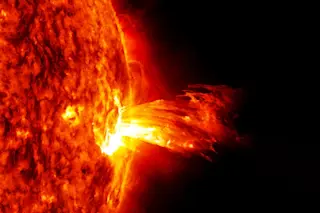Solar flares are explosive, energetic events that release intense radiation from the sun. They are caused by a buildup of magnetic energy — the sun also has an intense magnetic field — and a single flare can release the equivalent of millions of hydrogen bombs all going off at the same time. Now, for the first time, a team led by researchers from the National Center for Atmospheric Research and the Lockheed Martin Solar and Astrophysics Laboratory have simulated, in detail, the entire life cycle of a solar flare, from its initial buildup through its explosive outburst. The image above is an snippet from the team’s model. In it, violet colors represent plasma with temperatures less than 1 million kelvins (1.8 million degrees Fahrenheit); red colors show plasma with temperatures between 1 million and 10 million K (18 million F), and green shows the hottest plasma, with temperatures above 10 ...
Animation Shows The Life Cycle of a Solar Flare
Explore the solar flares life cycle, revealing intense radiation from the sun and its impact on satellites and electrical systems.
More on Discover
Stay Curious
SubscribeTo The Magazine
Save up to 40% off the cover price when you subscribe to Discover magazine.
Subscribe













